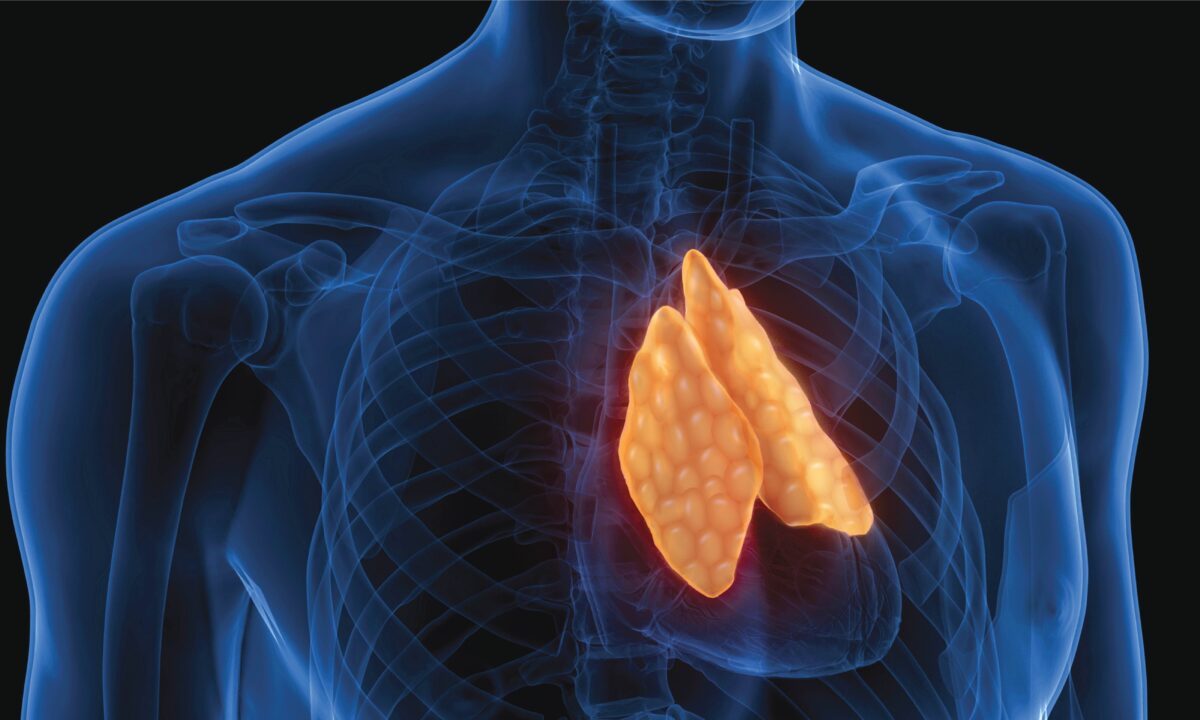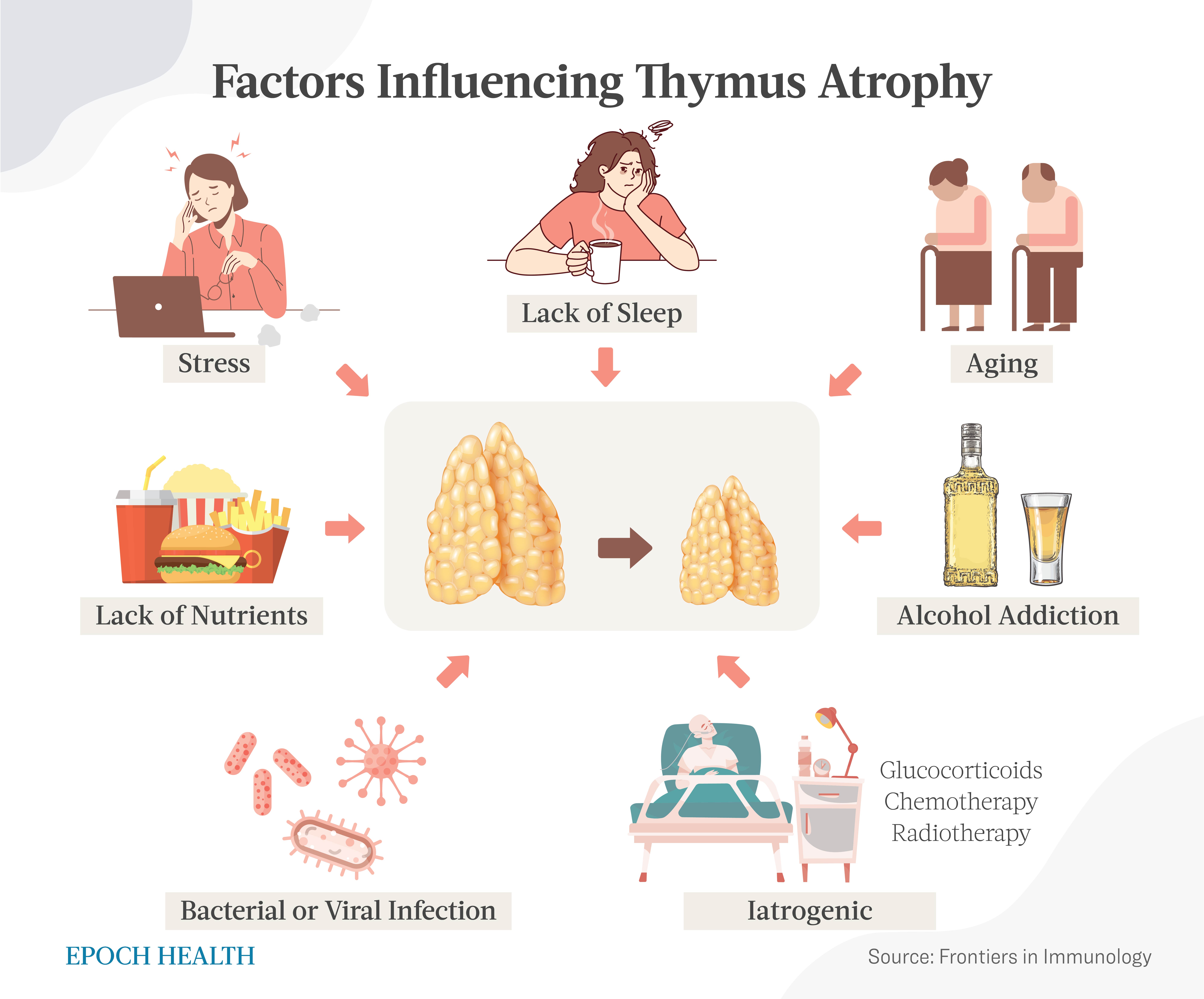


In this series, “The Miraculous Immune System,” we explore the true power of immunity and the organs that work tirelessly to protect the body.
Previously: The thymus may shrink after training T cells, but it continues to play critical roles—many of which we are only beginning to understand.
The little-known thymus gland is one of the body’s most essential immunological organs, beginning to develop before birth and reaching its peak function between the ages of 7 and 25.
The thymus is like a military base that trains soldiers—T cells—to battle for the immune system against dangers such as COVID-19 and cancer.
Despite its critical role, the thymus gland’s ability to stimulate effective T cell generation declines with age. Thymus atrophy or degradation may contribute to the overall reduction in immunological function that occurs with aging.
We will discuss further the association between the thymus and autoimmune diseases, factors that can cause thymus gland atrophy—and strategies for protecting and preserving thymus function in order to maintain a strong and healthy immune system throughout life.
Gradual thymus gland atrophy with age is a well-known physiological phenomenon; it’s a complex process that can be hastened by various triggers such as malnutrition, bacterial or viral infections, stressful situations, and alcoholism.
Jarrod Dudakov, an assistant professor at the University of Washington Department of Immunology, released a paper in Frontiers in Immunology that provides an in-depth review of the reasons for thymic atrophy.
When the body is deprived of nutrients, digestive disorders develop, resulting in a decline in thymus function and accelerated thymus degeneration.
Furthermore, a shortage of micronutrients in the body, such as zinc and antioxidants, may hasten thymic atrophy.
The thymus is extremely sensitive to acute stress-induced atrophy and is often referred to as a “barometer of stress” for the body. The more stress one has, the more likely the thymus will shrink and undergo acute thymic atrophy.
Glucocorticoids are potent cell death inducers and can cause the thymus to shrink quickly by making thymus cells die. Under stressful situations, glucocorticoids target thymocytes, an important type of thymus cell.
Although less studied, bacterial infections also undermine thymic function, mostly by inducing premature apoptosis (programmed cell death) in the thymus, resulting in acute thymic atrophy, according to the Dudakov paper.
Infections with Streptococcus suis can cause thymic atrophy by activating pro-apoptotic pathways in thymocytes. Additionally, infection with Mycobacterium tuberculosis can cause thymic atrophy by altering glucocorticoid levels.
Another study, published in the Canadian Journal of Microbiology, revealed that patients with COVID-19 (caused by SARS-CoV-2) may have pathological alterations that affect thymus development and may have fewer lymphocytes. Whether this affects thymic atrophy wasn’t confirmed.
A Russian autopsy study found that the volume of thymus tissue was significantly smaller in 54 people addicted to alcohol than in 53 nonalcoholic age-matched controls. The study reported similar findings regarding spleen tissue.
Studies have established that lack of sleep contributes to thymic atrophy.
The application of immunosuppressive therapy, such as chemo- and radiotherapy in cancer management or before transplantation, not only damages tumor cells and peripheral immune cells, but also has catastrophic effects on the thymic microenvironment, resulting in fewer T lymphocytes.
The thymus is extremely sensitive to chemotherapy, and 90 percent of the patients studied during the administration of chemotherapy showed thymus atrophy, with a decrease in thymic volume by an average of 43 percent during the first course of chemotherapy and 36 percent during the second.
Although the thymus can degenerate, it also has a powerful ability to regenerate. In the chemotherapy study described above, thymus regrowth was observed in 90 percent of the patients studied.
T cell regeneration after chemotherapy depends on residual thymic function and age.
A study conducted by the Scripps Research Institute found that the thymus plays a role in the recovery of the T cell population after chemotherapy-induced lymphopenia. The enlargement of the thymus gland was evident in adult patients ages 18 to 49 but not in elderly patients (ages 70 to 91).
The study suggests that the adult thymus has the ability to regenerate and play a significant role in rebuilding the peripheral T cell pool after chemotherapy-induced lymphopenia, at least up to middle age.
Another study found that the thymus could regenerate an important white blood cell (CD4+ T lymphocytes) in children undergoing chemotherapy, but that ability declined with age, even shortly after adolescence. The study highlights the importance of preserving residual thymic function in patients before undergoing chemotherapy in order to facilitate rapid T cell regeneration.
The importance of the immune cells the thymus creates has triggered interest in finding ways to induce thymus regeneration. Scientists have proposed a number of therapeutic strategies to boost thymus regeneration, including cytokines, growth factors, hormones or hormone-like mediators, and cell-based approaches.
Dudakov proposed numerous techniques for protecting the thymus, including one to directly activate cells capable of producing thymocytes in the bone marrow or in the thymus. He stated that inducing these precursor cell populations to evolve into mature thymocytes can improve thymic function.
There are numerous simple and effective techniques to help preserve the thymus and boost immunity.
Many nutrients act as co-factors in the synthesis, secretion, and activity of thymic hormones. Specific nutritional deficits can result in diminished thymic hormone activity and poor immunological function.
Some of the most important nutrients for thymus protection are zinc, vitamin E, and vitamin C. These nutrients promote thymic hormone activity and cell-mediated immunity.
A 2022 immunology study confirmed that zinc supplementation can alleviate thymic atrophy by enhancing immune cells.
Foods rich in these thymus-supporting nutrients include:
Numerous studies have proven that meditation is an effective stress management method. According to the Harvard Health Journal, research has even indicated that mindfulness meditation may have a longer-lasting effect on stress reduction than taking a vacation.
A study in the journal Aging Cell compared the immune systems of adults aged 55 to 79 who have been physically active for most of their lives with those of inactive older adults and of young adults who don’t exercise regularly.
The researchers observed that individuals who regularly cycled had higher levels of cytokines that help safeguard the thymus, such as IL-7, in their blood. Levels of IL-6, a cytokine that causes thymic atrophy, were lower in cyclists.
Researchers also observed less of a reduction in immune function with age in the cyclists. The study suggests that physical activity helps slow down some of the age-related changes that occur in the immune system.
Moreover, extensive evidence suggests that exercise has positive effects on the immune system. It’s widely recognized that moderate-intensity exercise lasting up to 45 minutes provides benefits to the body’s immune response, especially for older adults and individuals with chronic conditions.
Exercise increases blood flow, allowing nutrients to reach the body’s most critical areas and removing waste materials.
Exercise also increases body temperature, which makes it more difficult for infectious microorganisms to survive. Additionally, it can improve sleep, which strengthens the immune system.
Getting enough sleep is crucial for a strong immune system and overall well-being. Getting seven to nine hours of restful sleep each night helps support the health of the thymus gland and keeps the immune system working at its best.
Exposure to contaminants such as environmental toxins, cigarette smoke, alcohol, and hazardous chemicals can affect the thymus.
Medication use should be avoided as much as possible. Drugs such as corticosteroids can have a harmful effect on thymus function if used chronically or excessively. Work with a health care expert to explore alternative treatments or reduce the duration and dosage of drugs.
To summarize, a healthy thymus is vital to immune health. Healthy lifestyle choices can prevent thymus atrophy and encourage regeneration. These specific strategies protect the thymus and help preserve its function throughout life.
Next: Bone marrow, though mysterious, has essential functions, and it needs to be safeguarded to optimize health.
Read Part 1: The Silent Gatekeepers of Your Immunity Many People Don’t Know Of
Read Part 2: Tonsillectomy: A ‘Minor’ Procedure With Major Long-Term Risks
Read Part 3: Many People Have Removed an Important Body Part, Which May Increase 4 Cancer Risks
Read Part 4: Beyond Detox: Unlocking the Secret Healing Power of the Lymphatic System
Read Part 5: Building a Strong Defense: Boost the Lymphatic System and Detoxify After COVID-19 Vaccines
Read Part 6: Your Miraculous Spleen Works Tirelessly: Cleans Your Blood and Protects Against Viral Assaults
Read Part 7: Beyond the Knife: Warning Signs of an Unhealthy Spleen and 6 Practical Ways to Protect It
Read Part 8: Neither Shrunken Nor Useless: The Thymus Remains Essential to Long-Term Health
Ashwell, J. D., M. Lu, F. W., & Vacchio, M. S. (2003). Glucocorticoids in T Cell Development and Function*. https://doi.org/10.1146/annurev.immunol.18.1.309
Ageev, A. K., Sidorin, V. S., Rogachev, M. V., & Timofeev, I. V. (1986). Morfologicheskaia kharakteristika izmeneniĭ vilochkovoĭ zhelezy i selezenki pri alkogolizme [Morphologic characteristics of the changes in the thymus and spleen in alcoholism]. Arkhiv patologii, 48(10), 33–39. https://pubmed.ncbi.nlm.nih.gov/3800680/
Choyke, P. L., Zeman, R. K., Gootenberg, J. E., Greenberg, J. N., Hoffer, F., & Frank, J. A. (1987). Thymic atrophy and regrowth in response to chemotherapy: CT evaluation. AJR. American Journal of roentgenology, 149(2), 269–272. https://doi.org/10.2214/ajr.149.2.269
Sfikakis, P. P., Gourgoulis, G. M., Moulopoulos, L. A., Kouvatseas, G., Theofilopoulos, A. N., & Dimopoulos, M. A. (2005). Age-related thymic activity in adults following chemotherapy-induced lymphopenia. European journal of clinical investigation, 35(6), 380–387. https://doi.org/10.1111/j.1365-2362.2005.01499.x
Mackall C L, Fleisher T A, Brown M R, Andrich M P, Chen C C, Feuerstein I M, Horowitz M E, Magrath I T, Shad A T, Steinberg S M. Age, thymopoiesis, and CD4+ T-lymphocyte regeneration after intensive chemotherapy. N Engl J Med. 1995;332:143–149. DOI: 10.1056/NEJM199501193320303
Leblond V, Othman T B, Blanc C, Theodorou I, Choquet S, Sutton L, Debre P, Autran B. Expansion of CD4+CD7– T cells, a memory subset with preferential interleukin-4 production, after bone marrow transplantation. Transplantation. 1997;64:1453– 1459.
Storek J, Witherspoon R P, Storb R. T cell reconstitution after bone marrow transplantation into adult patients does not resemble T cell development in early life. Bone Marrow Transplant. 1995;16:413–425.
Duah, M., Li, L., Shen, J., Lan, Q., Pan, B., & Xu, K. (2021). Thymus Degeneration and Regeneration. Frontiers in Immunology, 12. https://doi.org/10.3389/fimmu.2021.706244
Velardi, E., Tsai, J. J., & M., M. R. (2021). T cell regeneration after immunological injury. Nature Reviews Immunology, 21(5), 277-291. https://doi.org/10.1038/s41577-020-00457-z
Kinsella, S., & Dudakov, J. A. (2020). When the Damage Is Done: Injury and Repair in Thymus Function. Frontiers in Immunology, 11. https://doi.org/10.3389/fimmu.2020.01745
Coenen, A. M., & van Luijtelaar, E. L. (1985). Stress induced by three procedures of deprivation of paradoxical sleep. Physiology & behavior, 35(4), 501–504. https://doi.org/10.1016/0031-9384(85)90130-1
Khalid, W., Arshad, M. S., Ali Nawaz Ranjha, M. M., Różańska, M. B., Irfan, S., Shafique, B., Rahim, M. A., Khalid, M. Z., Abdi, G., & Kowalczewski, P. Ł. (2022). Functional constituents of plant-based foods boost immunity against acute and chronic disorders. Open Life Sciences, 17(1), 1075-1093. https://doi.org/10.1515/biol-2022-0104


